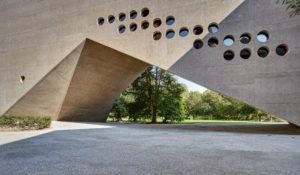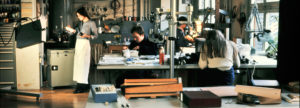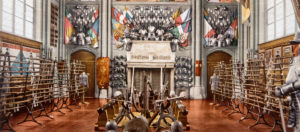
A tour of the National Museum around 1900
After the National Museum opened over 120 years ago it quickly began drawing large numbers of visitors. The lengthy construction and numerous political issues surrounding the institution’s inception had no doubt aroused the public’s curiosity. Free admission and the central location near Zurich’s main railway station did the rest, but enthusiasm centred on the spectacularly fitted-out exhibition halls.
After leaving the impressive concourse behind, visitors began a chronologically arranged tour of Swiss history. Beginning with the collection of prehistoric artefacts, the three floors of exhibition rooms—often given over to a particular set of objects—moved from one period to the next combining architectural features and furniture. The undisputed highlight and clinching attraction of the more than 50 rooms of exhibits was the giant Hall of Arms. Time-wise the presentation of Swiss history focused on the Middle Ages and early Modern Era, since the fractious emergence of the modern federal state in the 18th and 19th centuries was still regarded as too politically charged.
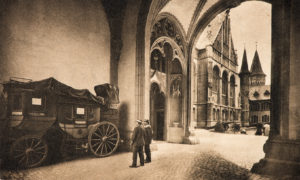
The entrance to the National Museum, decorated with rich Gothic tracery, stood by the path to the courtyard, next to the Gotthardpost coach.
The period architecture of the National Museum’s exhibition rooms was meant to be in harmony with their often original fixtures (ceilings, doors, columns, etc.) and the objects of the collections, thereby enabling the broad public to envisage and understand earlier times. Presentations were meant to bring artefacts to life in their presumed original surroundings and infuse the historical experience with an intense, enchanting atmosphere. A related concern was to have as few glass display cases as possible, with a view to further enhancing the immediacy of the experience. By comparison the exact arrangement of the artefacts was of far lesser importance: only years after the Museum opened did its experts hesitantly start realising the need for inscriptions. Moreover, they believed that as much as possible of the Museum’s entire collection had to be shown. However, there was no actual storeroom yet, so what could not be displayed had to be kept in the attic or the cellar. Consequently every square foot of exhibition space was used, even if this frequently hampered oversight (obviously the lack of identification tags did not help matters). Thus, a tour of the National Museum at the turn of the 20th must have been an impressive but, at the same time, taxing experience.
Room 1. Prehistoric artefacts
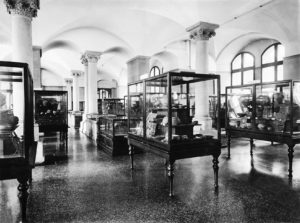
The tour through the “great picture book of Swiss history” began in a spacious columned hall displaying archaeological finds. Although one of the aims of the new Museum was to provide visitors with an unobstructed view of objects and show as few of them as possible in “display cases that would bore and confuse visitors”, the Prehistory section marked an exception because of its numerous glass-encased exhibits. Pile villages were given a central role in the history unfolding in this period: because of their inhabitants’ ability to overcome cantonal and linguistic frontiers, they were regarded as worthy forebears of the Swiss people.
Room 8. Gothic chapel
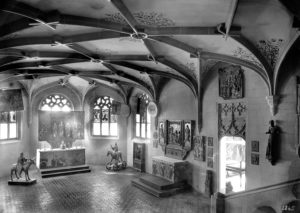
Already in its layout this room was modelled on the choir of a church and featured a typical Gothic ribbed vault ceiling. The paintings on this ceiling were copies of the ones that adorn the Kerchel in Schwyz and the tiled floor was a copy of the one in the church in Königsfelden. On the right, a door reproducing part of the entrance to the Grossmünster in Zurich led to the adjoining room. For its furnishings “the chapel would be endowed with church artefacts from the Gothic period”: for example, the high altar from Ticino, the side altar from the monastery in St. Gallen and the two statues of Jesus arriving in Jerusalem on a donkey.
Room 10. Treasure chamber
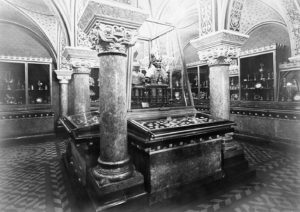
From the chapel, steps led down to the treasure chamber reminiscent of a Gothic crypt. There, beneath awesome arches, numerous religious and secular artefacts made of gold and silver were displayed.
Room 15. Way of the Cross

Adjacent to the chapel was a reconstructed Way of the Cross, the components of which originated in various places: the painted wooden ceiling was from the St. Sebastian Chapel in Igels; the rich Gothic tracery from the Way of the Cross of the Barfüsserkloster in Zurich; a total 18 glass paintings from all over Switzerland (as well as from Milan and Rottweil) encased in the window panes; and, finally, the arcades from the Way of the Cross of the Prediger Church in Zurich.
Room 20. Loggia
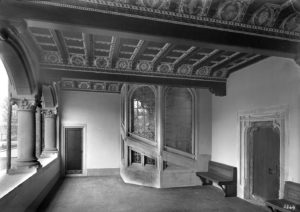
After nearly completing the tour of the ground floor, visitors no doubt welcomed a breath of fresh air in the loggia. The view of the Platzpromenade “allowed their eyes to rest on the magnificent greenness of the old trees lining the walkway”. Also featured were the copies of an Early Renaissance ceiling from the Casa del Negromante in Locarno and a carved door from the Fraumünster in Zurich.
Room 21. Corner room with stairs leading to the first upper floor

At the end of the ground floor tour, steps led up to the first upper floor where visitors continued in the opposite direction. Already in the early days of the National Museum, to be able to show at least a large part of the huge overall collection, even in the stairwell every free space was used to present artefacts.
Room 22. Pharmacy
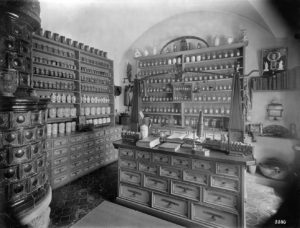
In this small room in the furthest corner of the ground floor, attentive visitors found a replica of a monasterial pharmacy from the 18th century. The furniture came from the Benedictine monastery in Muri, the vials and other chemist’s utensils from various other sites.
Room 29. Seidenhof room
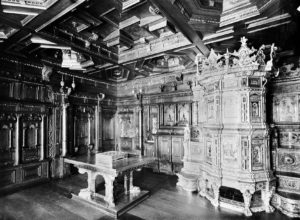
On the first upper floor was a whole series of rooms with period furnishings to browse through, including the Seidenhof room that was regarded as “the epitome of luxury in the National Museum’s examples of room furnishings from earlier times”. The 1592 stateroom modelled on the one at the Seidenhof Hotel in Zurich was an awesome sight with its sumptuous panelling and elaborate coffered ceiling. It also contained a brightly painted cockle stove from Winterthur.
Room 34. Winkelried room
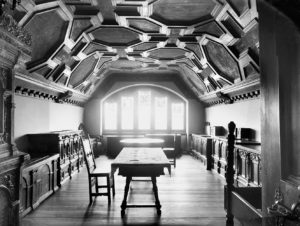
Although the tour had been originally planned to pass through only two stories (the ground floor and first upper floor), already before the Museum opened the second upper floor had to be worked into the exhibition’s design. This space included among other things a room from the Winkelriedhaus in Stans, with its particularly impressive hipped ceiling.
Room 56. Costume collection
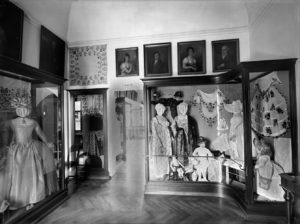
Only a few short years after its inauguration, the National Museum began to run short of space. Consequently, even the rooms in the second upper floor designed originally as the Director’s service apartment had to be turned into exhibition areas. There, visitors could admire the fashions of centuries past in the costume collection’s curved display cabinets. The exhibits also included 18th-century paintings belonging to the Tschudi family in Glarus.
Room 43. Lochmann room
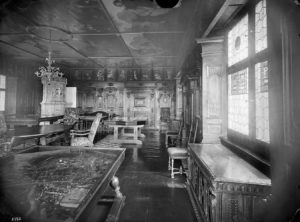
Back on the first upper floor, visitors came to a lavish baroque room from the Lochmann family’s house in Zurich. The ceiling was adorned with paintings of scenes from ancient mythology. Immediately underneath was a portrait gallery featuring 57 members of the French royal dynasty, prominent statesmen and military leaders from former times. Reliefs inlaid in the 18th-century table showed plans for the fortification of Zurich.
Room 46: Display cases with glassware

Plusieurs salles « mixtes » font la transition entre les pièces historiques et la salle d’armes. On y admire des vitrines abritant de nombreux objets en verre et en faïence, serrés les uns contre les autres.
Room 48. Ceramics collection

The ceramics collection, housed in a series of cabinets, was impressive because of its dense, floor-to-ceiling presentation of famed Winterthur faience, even where there was no direct contact with the ceiling (since the exhibition panels were placed freely about the room).
Room 50. Hall of Arms
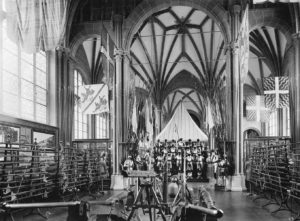
After passing through a few small rooms visitors arrived in the gigantic Hall of Arms—700 square metres of floor space 16 metres high—that marked the final crescendo of the tour through the National Museum. Reflecting the architecture of a neo-Gothic cathedral, the hall was bursting with armour, flags, trophies und weapons from what was touted as “the greatest political period of the Swiss Confederacy” in the 15th and 16th centuries. In this veritable tribute to the nation, visitors were to be moved by this feast for the eyes capturing the great past of their small country.
The first films made in the National Museum date from the 1930s. These early productions were funded by the legacy of Gustave Preiss (1881-1963).
The National Museum celebrates its 120th birthday
The Swiss National Museum in Zurich was inaugurated on 25 June 1898. To mark this anniversary, we propose a week-long look back at episodes in the institution’s 120-year history.
Monday:
Opening parade
The three-day opening festivities culminated on the afternoon of 25 June 1898 with a lavish celebration parade through downtown Zurich.
Tuesday:
Tour of the Museum
On a tour of the recently opened National Museum around 1900, visitors were mainly impressed with the spectacularly fitted-out exhibition halls.
Wednesday:
Postcards
As a Zurich landmark the National Museum was a greatly appreciated opportunity to write postcards, which were sent by the millions.
Thursday:
Behind the scenes
A look inside the museum’s offices, workshops and collections in the 1970s.
Friday:
Expansion
An enlargement was already planned when the National Museum was opened in 1898. Only 118 years later was the project fulfilled.

